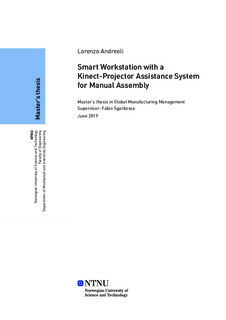| dc.description.abstract | Although automation has increased more and more in manufacturing companies over the last decades, manual labor is still used in a variety of complex tasks and is currently irreplaceable, especially in assembly operations. The problem of assisting and supporting the human worker during potentially complex assembly tasks is, therefore, very relevant. Clear and easy-to-read assembly instructions, error-proofing methods, and an intuitive user interface for the worker have the potential to reduce the cognitive workload of the operator, increase the productivity, improve the quality, reduce defects, and consequently reduce costs.
Digital technologies such as augmented reality and motion recognition sensors can help assembly workers in their tasks and have been subject of research with increased interest over the years. In this thesis, we develop a prototype of a smart workstation equipped with a Kinect-projector assistance system for manual assembly. By following a V-model for systems development approach, we identify key requirements for assistance systems for both continuously supporting workers and teaching assembly steps to workers. Thereby, based on the identified requirements, we design and build a functional prototype with the following features: in-situ projection visualization, Pick-by-Light, picking error-proofing, and gesture user interaction.
A case study in a laboratory is conducted to assess the prototype in terms of performance and accuracy, user acceptance and mental workload. The participants tested the assistance system together with two established methods in manual assembly (i.e. paper-based manuals and a mounted monitor) by assembling LEGO models of different product complexity. The results reveal that our system performs significantly better in terms of number of errors made by the workers, user acceptance, and mental workload required by the user to execute the assembly tasks. Further, they show that product complexity is a major factor in deciding whether adopting the assistance system. However, the measured task completion times were higher than using methods such as mounted monitors, therefore highlighting the limitations of the prototype and suggesting that further research is necessary in this regard. | |
